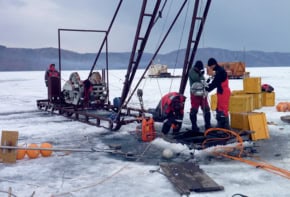The Neutron's Children: Nuclear Engineers and the Shaping of Identity
Sean F Johnston
2012 Oxford University Press £35.00/$62.99hb 328pp

A few years ago, some colleagues and I decided to set up a specialist group within the Institute of Physics (IOP) for physicists working in the nuclear industry. This task proved unexpectedly complex because questions were asked about the new group’s relationship to the IOP’s existing Nuclear Physics Group, its distinction from the Institute of Nuclear Engineers and – importantly – what it would be called. Eventually, we were able to set out an acceptable remit for the Nuclear Industry Group of the IOP, and all parties seemed satisfied with the result.
We did not realize it at the time, but I now suspect that our skirmish was only the latest in a long-running battle to determine an identity for nuclear professionals. In The Neutron’s Children: Nuclear Engineers and the Shaping of Identity, science historian Sean Johnston describes the opening salvoes in this battle, beginning with the nuclear-power programmes that sprang up in the US, UK and Canada in the aftermath of the Second World War. He follows them until the late 1960s, focusing firmly on the development of skills and expertise among the “nuclear engineers” who were needed to see these programmes to fruition.
The UK, US and Canada worked together on the Manhattan Project, but their nuclear interests diverged after the war’s end. This was partly down to the US’s McMahon Act of 1946, which excluded its wartime partners from information about nuclear systems, and forced the UK and Canada to develop their own. Initially, only the UK had a programme for power reactors, albeit one that was secondary to its programme for producing weapons-grade plutonium. However, it was not long before the US also began to think of nuclear power as a future source of electricity, and of reactors as a source for isotopes used in medicine and agriculture. Canada, for its part, had no interest in weapons, and put all its efforts into nuclear power.
Despite these different emphases, Johnston argues that all three countries faced the same questions. Who were the workers who would develop nuclear power systems? What knowledge did they need? What should be the roles of scientists (not just physicists, but chemists and biologists) and engineers? And which disciplines of engineering were required?
As Johnston shows, the difficulties of combining knowledge and approaches from science and engineering were not easily overcome. One of the barriers was geographic. In the US, scientific research was concentrated at the University of Chicago, while the Oak Ridge facility in Tennessee carried out engineering development and the remote Hanford site in Washington state hosted the plutonium production reactors. The UK also had clear distinctions between the different roles and sites. Harwell (Oxfordshire) carried out research, Risley (Lancashire) served as the engineering development centre and the reactors were built at relatively remote sites such as Windscale (Cumbria) and Dounreay (Caithness). One effect of this was that the sites had a tendency to work autonomously and not communicate well with each other, which led to poor overall control, as described by Harold Bolter in his book, Inside Sellafield. Efforts to mitigate this problem included, at one time, a regular private air service between north-west England and Dounreay in Scotland, where the landing was on the site runway from the days when the latter was a Fleet Air Arm base.
Even within a single site, the marriage between engineering and science was not always smooth. For example, the US plutonium production project was run by DuPont, a major industrial chemical firm. DuPont needed the scientists to determine the basic reactor physics data, and the scientists needed DuPont’s expertise in chemical engineering to produce a practical system. Eventually an uneasy collaboration led to more co-operation, and Johnston explains that this was thanks in part to the sterling efforts of scientists such as John Wheeler, who acted as an intermediary between DuPont and some of the more “recalcitrant” physicists, such as Eugene Wigner.
In the mid-1950s responsibility for training nuclear personnel (whether with scientific or engineering backgrounds) was largely in the hands of government-run facilities at Oak Ridge in the US, Chalk River in Canada and Harwell in the UK. All three operated reactor training schools, and it is worth emphasizing that they were entirely reactor-focused – the issue of waste was not high up on the agenda in those days, leading to many of our current clean-up and disposal problems. Gradually, though, university courses appeared to supplement site-based training. In the US, these included undergraduate courses, and this burgeoning university training – together with employment in both government-financed organizations and private companies – helped to clarify the identity of nuclear engineering as a profession. The UK, however, concentrated on postgraduate education, believing that while specific knowledge and expertise were necessary, these should be additional to basic training.
The UK’s engineering approach was also rooted more in practical expertise than formal qualifications, and site-based training for both scientists and engineers continued well into the 1980s. Partly as a result of this approach, the profession was slow to develop a separate status, and is arguably still not established. Canada, meanwhile, developed undergraduate courses in “nuclear engineering”, but their content was not easily defined and uptake was patchy, with many courses becoming unviable by the end of the 1960s. However, the relative absence of military influence on Canada’s nuclear specialists meant professionals there were less inhibited and their public visibility was high.
I joined the nuclear industry in the 1970s, which I suppose makes me one of the neutron’s grandchildren. However, many of the situations Johnston describes were still present. These included an uneasy alliance between scientists and engineers, who had different perks and conditions of employment; a lack of openness and a high degree of secrecy due to the industry’s military origins; and the relative geographical isolation of sites as a precaution against accidents. Johnston’s thesis is that these three characteristics, coupled with the industry’s origins in governmental programmes, were defining factors in the development of professional attitudes and approaches among nuclear practitioners. And all of them, Johnston argues, meant that members of the nuclear profession “might be perceived as suffering from arrested development, peculiar idiosyncrasies and worldview, insecure self-image, weak communication skills and poor socialization with their peers”.
I can recognize much of this generalization, as there were certainly a lot of oddballs around (and some today as well), although it does not seem to acknowledge the robust group lunchtime drinking culture that once prevailed. But nuclear power and its practitioners have other, more serious, crosses to bear. The industry, even when privatized, has never escaped the dead hand of government direction and manipulation. Nor has it really shaken off its military origins. Nuclear professionals have always had to fight battles for public acceptance, and today’s politicians seem to have no greater knowledge or willingness to face the real issues.
On the face of it, The Neutron’s Children might seem like a book of limited interest to the general reader, and the author’s punning use of terms from the nuclear field grates a bit (I say this even though – as the headline of this review shows – I do not mind a pun or two). Nonetheless, it is a fascinating account of how an entire industry developed from very sparse beginnings and, like all good histories, it offers lessons to be learned. The nuclear profession was created in a relatively short period after the Second World War, but its members were never given the security of future employment that would ensure a continuing cadre. Instead, there has been a waxing and waning of interest in nuclear power and, as a result, we are losing the continuity of our nuclear knowledge and expertise. If we are to fulfil the “nuclear renaissance” goal of developing and providing carbon-free electricity, we need to focus on creating the neutron’s great-grandchildren, and several generations beyond that – whatever we decide to call them.



